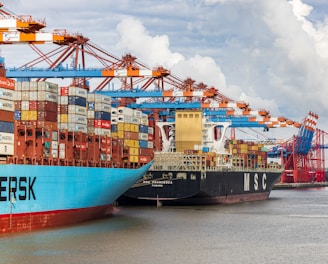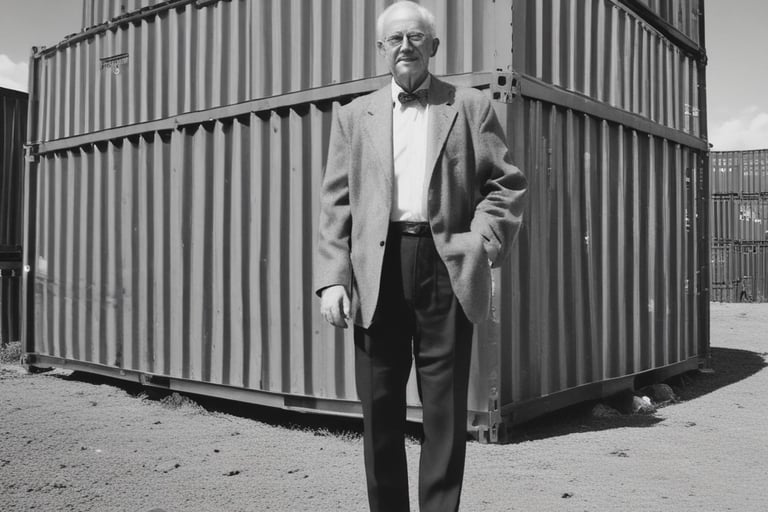



17 Million Shipping Containers: A Wall Around the World — Twice!
Have you ever seen a massive cargo ship stacked high with metal boxes? Those boxes are called shipping containers, and there are more than 17 million of them in use today. But here's something wild to imagine: If we stacked all these containers end-to-end, we could build a wall around the Earth — not once, but twice!
7/15/20243 min read

The World Uses Over 17 Million Shipping Containers: Enough to Circle the Earth Twice
Shipping containers are the unsung heroes of the global economy. Although they may seem like simple steel boxes, they form the backbone of international trade, enabling the efficient movement of goods across continents and oceans. Today, over 17 million shipping containers are in use globally—a number so vast that, if placed end-to-end, these containers could encircle the Earth more than twice.
This article explores the scale of global container usage, its implications for global trade, and how this standardized system has reshaped logistics and transportation over the past several decades.
Understanding the Shipping Container
The modern shipping container—also known as an intermodal container—was first introduced in the 1950s by American entrepreneur Malcolm McLean. Its invention revolutionized cargo transport by standardizing container sizes and enabling seamless transfer between ships, trucks, and trains without unloading the contents.
The two most common container sizes are:
* Twenty-foot Equivalent Unit (TEU): 20 feet long, 8 feet wide, 8.5 feet high
* Forty-foot Equivalent Unit (FEU): Double the length of a TEU
These containers are made of durable steel, designed to be stackable and weather-resistant. Their modular nature has made them a universal solution for transporting a wide range of goods, from consumer electronics and apparel to raw materials and machinery.
Scale and Distribution
As of current estimates, more than 17 million containers are active in the global supply chain. These are moved by approximately 60,000 merchant ships that operate worldwide. According to the World Shipping Council and UNCTAD (United Nations Conference on Trade and Development), over 90% of global trade by volume is carried by sea, with containerized cargo making up a significant portion.
To understand the scale:
Earth’s circumference at the equator is about *40,075 kilometers**
A single 20-foot container measures *6.1 meters** in length
17 million containers × 6.1 meters = *103,700 kilometers**
This means that, in theory, these containers could form a continuous chain around the Earth over two and a half times.
Strategic Importance in Global Trade
The widespread use of containers has created a system known as containerization, which has greatly reduced shipping costs, improved cargo security, and decreased handling time. It enables the globalization of manufacturing by allowing companies to ship components and finished products with remarkable efficiency.
Key benefits include:
* Standardization: Uniform sizes allow for predictable handling and storage
* Intermodal flexibility: Easy transfer between ships, trucks, and trains
* Cost reduction: Bulk shipping significantly lowers per-unit transportation costs
* Security: Sealed containers reduce the risk of theft and tampering
Major ports like Shanghai, Singapore, Rotterdam, and Los Angeles handle millions of containers annually, serving as critical hubs in the global logistics network.
Environmental and Technological Challenges
While containers have optimized global logistics, the container shipping industry also faces several challenges. Environmental concerns related to fossil fuel consumption, CO₂ emissions, and waste management are prompting a shift toward greener alternatives.
Key developments include:
* Autonomous and electric-powered ships
* Smart containers equipped with GPS and sensors for real-time tracking
* Recycling and repurposing of decommissioned containers into housing, retail units, and urban infrastructure
Future Trends
With advancements in artificial intelligence, blockchain, and Internet of Things (IoT) technology, the container industry is entering a phase of transformation. Smart logistics systems are being designed to reduce inefficiencies, improve route planning, and optimize container utilization.
Moreover, container ports are investing in automated cranes, drones, and digital twins to manage increasing volumes while minimizing environmental impacts. These innovations aim to maintain the balance between growth in global trade and the urgency of sustainability.
Conclusion
The image of 17 million containers forming a wall around the planet may seem dramatic, but it effectively illustrates the immense scale and reach of modern logistics. Containers are more than metal boxes—they are the fundamental units of global commerce. As the world moves toward smarter and greener trade practices, the role of the humble shipping container will continue to evolve, shaping the flow of goods in the 21st century and beyond.
References
International Maritime Organization. (2020). Fourth IMO GHG Study 2020. https://www.imo.org
Levinson, M. (2016). The box: How the shipping container made the world smaller and the world economy bigger (2nd ed.). Princeton University Press.
UNCTAD. (2023). Review of Maritime Transport 2023. United Nations Conference on Trade and Development. https://unctad.org/webflyer/review-maritime-transport-2023
World Shipping Council. (2023). Industry Statistics. https://www.worldshipping.org


